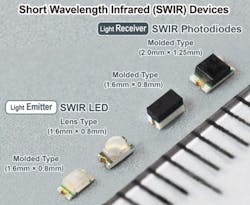What you’ll learn:
- The need for advanced material sensing in applications like medical and industrial.
- How SWIR devices address material sensing.
The continued expansion of intelligent systems in every aspect of society is creating an equally growing demand for sophisticated sensor solutions. The more advanced the system, the more reliant it is on information on the task at hand as well as its own performance to properly address the application. There’s no precision without feedback, and without precise and accurate sensor data, the system can’t operate optimally.
Non-invasive sensing technologies that provide detailed information about target objects can significantly empower next-generation applications, such as live skin detection, biosensing, and materials processing (Fig. 1). Infrared sensing technology is able to address these needs in a cost-effective manner.
Categorized by wavelength, the area of most use currently is the short-wave infrared (SWIR) range from 1.0 to 3.0 µm. Semiconductor devices like SWIR LED photodiodes can address complex sensing applications by leveraging the properties and capabilities of SWIR light.
By absorbing photons that generate an electric charge proportional to the light intensity, photodiodes detect and measure light levels—in this case generated by SWIR emitters. The emitter and photodiode are fundamental to SWIR sensor functionality and are paired in any SWIR sensing solution.
SWIR Sensors and Applications
The emitter side of a SWIR sensing solution can use different light-source types, including LEDs and VCSELs, with the emitter material and design determining the specific wavelength of SWIR light emitted. Common emitter materials include indium gallium arsenide (InGaAs), indium phosphide (InP), and gallium arsenide (GaAs), as they offer a high level of power efficiency and thermal stability. Oftentimes, InGaAs is favored due to its ideal bandgap, high quantum efficiency, and excellent noise characteristics.
SWIR photodetectors are constructed similarly, with an arrangement optimized for light absorption rather than light emission, converting incoming SWIR light into an electrical signal that can be processed and analyzed by the system. Common photodiode materials include InGaAs and mercury cadmium telluride (HgCdTe or MCT), which can be made to match the energy of SWIR light used.
SWIR sensing solutions address tasks such as moisture detection, skin detection, skin hydration, glucose monitoring, and other material-measurement applications. For example, in the case of moisture detection, water has distinct absorption characteristics in the SWIR range, and the proper sensor can detect environmental parameters such as humidity, atmospheric gases, and soil moisture.
Such SWIR devices are also able to detect pollution, smoke, and other airborne particles, making them valuable for air-quality monitoring systems and other environmental monitoring applications.
For biometrics and security applications, human skin has a specific reflective signature in the SWIR range that can be detected and used for identification or verification, providing a non-contact, non-invasive method for live fingerprint detection and recognition. In healthcare settings, SWIR devices are capable of performing non-invasive biosensing. They detect subtle changes in aspects such as blood glucose levels by measuring the absorption and reflection of SWIR light, especially useful in applications that require constant monitoring.
Creating SWIR Sensor Solutions
Addressing the need for advanced non-invasive sensing solutions, ROHM Semiconductor developed mass-production technology for SWIR devices (Fig. 2) in 1608-size (1.6 × 0.8 mm) SMT packaging, leveraging manufacturing tech cultivated through the mass production of compound semiconductors.
SWIR photodiodes are characterized by a tradeoff relationship in light detection area vs. response speed. However, since a larger area provides greater sensitivity, ROHM will offer four models in two light-receiving diameter sizes and two package types, making it possible to select the right product based on application requirements.
SWIR devices present a high-performance option for light-sensing applications, taking advantage of the properties of the short-wave infrared region, with ultra-high sensitivity, resolution, and stability, to enable these sensors to address a variety of sectors and application areas.



